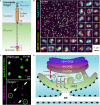Tales of the ER-Golgi Frontier: Drosophila-Centric Considerations on Tango1 Function
- PMID: 33505971
- PMCID: PMC7829582
- DOI: 10.3389/fcell.2020.619022
Tales of the ER-Golgi Frontier: Drosophila-Centric Considerations on Tango1 Function
Abstract
In the secretory pathway, the transfer of cargo from the ER to the Golgi involves dozens of proteins that localize at specific regions of the ER called ER exit sites (ERES), where cargos are concentrated preceding vesicular transport to the Golgi. Despite many years of research, we are missing crucial details of how this highly dynamic ER-Golgi interface is defined, maintained and functions. Mechanisms allowing secretion of large cargos such as the very abundant collagens are also poorly understood. In this context, Tango1, discovered in the fruit fly Drosophila and widely conserved in animal evolution, has received a lot of attention in recent years. Tango1, an ERES-localized transmembrane protein, is the single fly member of the MIA/cTAGE family, consisting in humans of TANGO1 and at least 14 different related proteins. After its discovery in flies, a specific role of human TANGO1 in mediating secretion of collagens was reported. However, multiple studies in Drosophila have demonstrated that Tango1 is required for secretion of all cargos. At all ERES, through self-interaction and interactions with other proteins, Tango1 aids ERES maintenance and tethering of post-ER membranes. In this review, we discuss discoveries on Drosophila Tango1 and put them in relation with research on human MIA/cTAGE proteins. In doing so, we aim to offer an integrated view of Tango1 function and the nature of ER-Golgi transport from an evolutionary perspective.
Keywords: COPII; ER exit site; collagen; extracellular matrix; secretion; traffic.
Copyright © 2021 Feng, Yang and Pastor-Pareja.
Conflict of interest statement
The authors declare that the research was conducted in the absence of any commercial or financial relationships that could be construed as a potential conflict of interest.
Figures


Similar articles
-
Tango1 spatially organizes ER exit sites to control ER export.J Cell Biol. 2017 Apr 3;216(4):1035-1049. doi: 10.1083/jcb.201611088. Epub 2017 Mar 9. J Cell Biol. 2017. PMID: 28280122 Free PMC article.
-
Tango1 coordinates the formation of endoplasmic reticulum/Golgi docking sites to mediate secretory granule formation.J Biol Chem. 2019 Dec 20;294(51):19498-19510. doi: 10.1074/jbc.RA119.011063. Epub 2019 Nov 5. J Biol Chem. 2019. PMID: 31690624 Free PMC article.
-
Dual function for Tango1 in secretion of bulky cargo and in ER-Golgi morphology.Proc Natl Acad Sci U S A. 2017 Nov 28;114(48):E10389-E10398. doi: 10.1073/pnas.1711408114. Epub 2017 Nov 14. Proc Natl Acad Sci U S A. 2017. PMID: 29138315 Free PMC article.
-
Not just a cargo receptor for large cargoes; an emerging role of TANGO1 as an organizer of ER exit sites.J Biochem. 2019 Aug 1;166(2):115-119. doi: 10.1093/jb/mvz036. J Biochem. 2019. PMID: 31098622 Review.
-
The pathway of collagen secretion.Annu Rev Cell Dev Biol. 2015;31:109-24. doi: 10.1146/annurev-cellbio-100913-013002. Epub 2015 Sep 29. Annu Rev Cell Dev Biol. 2015. PMID: 26422332 Review.
Cited by
-
A Systematic Compilation of Human SH3 Domains: A Versatile Superfamily in Cellular Signaling.Cells. 2023 Aug 12;12(16):2054. doi: 10.3390/cells12162054. Cells. 2023. PMID: 37626864 Free PMC article. Review.
-
p24-Tango1 interactions ensure ER-Golgi interface stability and efficient transport.J Cell Biol. 2024 May 6;223(5):e202309045. doi: 10.1083/jcb.202309045. Epub 2024 Mar 12. J Cell Biol. 2024. PMID: 38470362 Free PMC article.
-
Mechanisms of COPII coat assembly and cargo recognition in the secretory pathway.Nat Rev Mol Cell Biol. 2025 Mar 25:10.1038/s41580-025-00839-y. doi: 10.1038/s41580-025-00839-y. Online ahead of print. Nat Rev Mol Cell Biol. 2025. PMID: 40133632 Free PMC article. Review.
-
Characterization of a fold in TANGO1 evolved from SH3 domains for the export of bulky cargos.Nat Commun. 2023 Apr 20;14(1):2273. doi: 10.1038/s41467-023-37705-4. Nat Commun. 2023. PMID: 37080980 Free PMC article.
-
Repeat length of C9orf72-associated glycine-alanine polypeptides affects their toxicity.Acta Neuropathol Commun. 2023 Aug 29;11(1):140. doi: 10.1186/s40478-023-01634-6. Acta Neuropathol Commun. 2023. PMID: 37644512 Free PMC article.
References
-
- Bosserhoff A. K., Kondo S., Moser M., Dietz U. H., Copeland N. G., Gilbert D. J., et al. (1997). Mouse CD-RAP/MIA gene: structure, chromosomal localization, and expression in cartilage and chondrosarcoma. Dev. Dyn. 208 516–525. 10.1002/(SICI)1097-0177(199704)208:4<516::AID-AJA7>3.0.CO;2-L - DOI - PubMed
Publication types
LinkOut - more resources
Full Text Sources
Other Literature Sources
Molecular Biology Databases

